Satellite-Derived Correlation of SO2, NO2, and Aerosol Optical Depth with Meteorological Conditions over East Asia from 2005 to 2015
Abstract
1. Introduction
2. Materials and Methods
2.1. Gaseous Pollutant Data
2.2. Aerosol Data
2.3. Meteorological Data
2.4. Region of Study
3. Results
3.1. Spatial Distribution of Airborne Species over East Asia
3.2. Temporal Evolution of Pollutants
3.2.1. Method of Seasonal Adjustment
3.2.2. Temporal Evaluation of Pollutants for Each Monitoring Region
3.3. Impact of Meteorological Conditions on Pollutants
3.3.1. Correlation Coefficient between Meteorological Factors and Pollutants
3.3.2. Transport of Pollutants
3.3.3. Effect of Precipitation
4. Discussion and Conclusions
Supplementary Materials
Author Contributions
Funding
Acknowledgments
Conflicts of Interest
References
- Lu, Z.; Zhang, Q.; Streets, D.G. Sulfur dioxide and primary carbonaceous aerosol emissions in China and India, 1996–2010. Atmos. Chem. Phys. Discuss. 2011, 11, 9839–9864. [Google Scholar] [CrossRef]
- Streets, D.; Waldhoff, S.; Streets, D. Present and future emissions of air pollutants in China. Atmos. Environ. 2000, 34, 363–374. [Google Scholar] [CrossRef]
- Liu, F.; Zhang, Q.; Tong, D.; Zheng, B.; Li, M.; Huo, H.; He, K.B. High-resolution inventory of technologies, activities, and emissions of coal-fired power plants in China from 1990 to 2010. Atmos. Chem. Phys. Discuss. 2015, 15, 13299–13317. [Google Scholar] [CrossRef]
- Hua, S.; Tian, H.; Wang, K.; Zhu, C.; Gao, J.; Ma, Y.; Xue, Y.; Wang, Y.; Duan, S.; Zhou, J. Atmospheric emission inventory of hazardous air pollutants from China’s cement plants: Temporal trends, spatial variation characteristics and scenario projections. Atmos. Environ. 2016, 128, 1–9. [Google Scholar] [CrossRef]
- Azimi, M.; Feng, F.; Yang, Y. Air Pollution Inequality and Its Sources in SO2 and NOX Emissions among Chinese Provinces from 2006 to 2015. Sustainability 2018, 10, 367. [Google Scholar] [CrossRef]
- Seinfeld, J.H.; Pandis, S.N. Atmospheric Chemistry and Physics: From Air Pollution to Climate Change, 3rd ed.; John Wiley Sons: Hoboken, NJ, USA, 2016. [Google Scholar]
- USEPA. Our Nation’s Air Status and Trends Through 2010; Technical Report EPA-454/R-12-001; USEPA: Washington, DC, USA, 2012.
- Chou, C.C.-K.; Lee, C.; Yuan, C.; Hsu, W.; Lin, C.-Y.; Hsu, S.-C.; Liu, S. Implications of the chemical transformation of Asian outflow aerosols for the long-range transport of inorganic nitrogen species. Atmos. Environ. 2008, 42, 7508–7519. [Google Scholar] [CrossRef]
- Lin, C.-Y.; Chou, C.C.; Wang, Z.; Lung, S.-C.; Lee, C.-T.; Yuan, C.-S.; Chen, W.-N.; Chang, S.-Y.; Hsu, S.-C.; Chen, W.-C.; et al. Impact of different transport mechanisms of Asian dust and anthropogenic pollutants to Taiwan. Atmos. Environ. 2012, 60, 403–418. [Google Scholar] [CrossRef]
- Oh, H.-R.; Ho, C.-H.; Kim, J.; Chen, D.; Lee, S.; Choi, Y.-S.; Chang, L.-S.; Song, C.-K. Long-range transport of air pollutants originating in China: A possible major cause of multi-day high-PM10 episodes during cold season in Seoul, Korea. Atmos. Environ. 2015, 109, 23–30. [Google Scholar] [CrossRef]
- Naja, M.; Akimoto, H. Contribution of regional pollution and long-range transport to the Asia-Pacific region: Analysis of long-term ozonesonde data over Japan. J. Geophys. Res. Space Phys. 2004, 109. [Google Scholar] [CrossRef]
- Lin, M.; Fiore, A.M.; Horowitz, L.W.; Cooper, O.R.; Naik, V.; Holloway, J.; Johnson, B.J.; Middlebrook, A.M.; Oltmans, S.J.; Pollack, I.B.; et al. Transport of Asian ozone pollution into surface air over the western United States in spring, J. Geophys. Res. 2012, 117, D00V07. [Google Scholar] [CrossRef]
- Lin, J.; Pan, D.; Davis, S.J.; Zhang, Q.; He, K.; Wang, C.; Streets, D.G.; Wuebbles, D.J.; Guan, D. China’s international trade and air pollution in the United States. Proc. Natl. Acad. Sci. USA 2014, 111, 1736–1741. [Google Scholar] [CrossRef] [PubMed]
- Yu, H.; Remer, L.A.; Chin, M.; Bian, H.; Kleidman, R.G.; Diehl, T. A satellite-based assessment of transpacific transport of pollution aerosol. J. Geophys. Res. 2008, 113, 1–15. [Google Scholar] [CrossRef]
- Van Donkelaar, A.; Martin, R.V.; Leaitch, W.R.; Macdonald, A.M.; Walker, T.W.; Streets, D.G.; Zhang, Q.; Dunlea, E.J.; Jimenez, J.L.; Dibb, J.E.; et al. Analysis of aircraft and satellite measurements from the Intercontinental Chemical Transport Experiment (INTEX-B) to quantify long-range transport of East Asian sulfur to Canada. Atmos. Chem. Phys. Discuss. 2008, 8, 2999–3014. [Google Scholar] [CrossRef]
- Krotkov, N.A.; McLinden, C.A.; Li, C.; Lamsal, L.N.; Celarier, E.A.; Marchenko, S.V.; Swartz, W.H.; Bucsela, E.J.; Joiner, J.; Duncan, B.N.; et al. Aura OMI observations of regional SO2 and NO2 pollution changes from 2005 to 2015. Atmos. Chem. Phys. Discuss. 2016, 16, 4605–4629. [Google Scholar] [CrossRef]
- Lu, Z.; Streets, D.G.; de Foy, B.; Krotkov, N.A. Ozone Monitoring Instrument Observations of Interannual Increases in SO2 Emissions from Indian Coal-Fired Power Plants during 2005–2012. Environ. Sci. Technol. 2013, 47, 13993–14000. [Google Scholar] [CrossRef] [PubMed]
- Hilboll, A.; Richter, A.; Burrows, J.P. Long-term changes of tropospheric NO2 over megacities derived from multiple satellite instruments. Atmos. Chem. Phys. Discuss. 2013, 13, 4145–4169. [Google Scholar] [CrossRef]
- Krotkov, N.A.; McLinden, C.A.; Li, C.; Lamsal, L.N.; Celarier, E.A.; Marchenko, S.V.; Swartz, W.H.; Bucsela, E.J.; Joiner, J.; Duncan, B.N.; et al. Aura OMI observations of regional SO2 and NO2 pollution changes from 2005 to 2014. Atmos. Chem. Phys. Discuss. 2015, 15, 26555–26607. [Google Scholar] [CrossRef]
- Lamsal, L.N.; Duncan, B.N.; Yoshida, Y.; Krotkov, N.A.; Pickering, K.E.; Streets, D.G.; Lu, Z. US NO2 trends (2005–2013): EPA Air Quality System (AQS) data versus improved observations from the Ozone Monitoring Instrument (OMI). Atmos. Environ. 2015, 110, 130–143. [Google Scholar] [CrossRef]
- Zhang, L.; Lee, C.S.; Zhang, R.; Chen, L. Spatial and temporal evaluation of long term trend (2005–2014) of OMI retrieved NO2 and SO2 concentrations in Henan Province, China. Atmos. Environ. 2017, 154, 151–166. [Google Scholar] [CrossRef]
- Russell, A.R.; Valin, L.C.; Cohen, R.C. Trends in OMI NO2 observations over the United States: Effects of emission control technology and the economic recession. Atmos. Chem. Phys. Discuss. 2012, 12, 12197–12209. [Google Scholar] [CrossRef]
- Van Der A, R.J.; Mijling, B.; Ding, J.; Koukouli, M.E.; Liu, F.; Li, Q.; Mao, H.; Theys, N. Cleaning up the air: Effectiveness of air quality policy for SO2 and NOx emissions in China. Atmos. Chem. Phys. Discuss. 2017, 17, 1775–1789. [Google Scholar] [CrossRef]
- Zhao, B.; Wang, S.; Wang, J.; Fu, J.S.; Liu, T.; Xu, J.; Fu, X.; Hao, J. Impact of national NOx and SO2 control policies on particulate matter pollution in China. Atmos. Environ. 2013, 77, 453–463. [Google Scholar] [CrossRef]
- Eatough, D.; Caka, F.; Farber, R. The Conversion of SO2 to Sulfate in the Atmosphere. Isr. J. Chem. 1994, 34, 301–314. [Google Scholar] [CrossRef]
- Khoder, M.; Khoder, M. Atmospheric conversion of sulfur dioxide to particulate sulfate and nitrogen dioxide to particulate nitrate and gaseous nitric acid in an urban area. Chemosphere 2002, 49, 675–684. [Google Scholar] [CrossRef]
- Turalıoğlu, F.S.; Nuhoglu, A.; Bayraktar, H.; Turalioglu, F.S. Impacts of some meteorological parameters on SO2 and TSP concentrations in Erzurum, Turkey. Chemosphere 2005, 59, 1633–1642. [Google Scholar] [CrossRef] [PubMed]
- Wallace, J.; Kanaroglou, P. The sensitivity of OMI-derived nitrogen dioxide to boundary layer temperature inversions. Atmos. Environ. 2009, 43, 3596–3604. [Google Scholar] [CrossRef]
- Bralić, M.; Buljac, M.; Periš, N.; Buzuk, M.; Dabić, P.; Brinić, S. Monthly and Seasonal Variations of NO2, SO2 and Black-smoke Located Within the Sport District in Urban Area, City of Split, Croatia. Croat. Chem. Acta 2012, 85, 139–145. [Google Scholar] [CrossRef]
- Malkki, A.; Saari, H.; Levelt, P.; Oord, G.V.D.; Dobber, M.; Visser, H.; De Vries, J.; Stammes, P.; Lundell, J. The ozone monitoring instrument. IEEE Trans. Geosci. Remote Sens. 2006, 44, 1093–1101. [Google Scholar] [CrossRef]
- Li, C.; Joiner, J.; Krotkov, N.A.; Bhartia, P.K. A fast and sensitive new satellite SO2 retrieval algorithm based on principal component analysis: Application to the ozone monitoring instrument. Geophys. Res. Lett. 2013, 40, 6314–6318. [Google Scholar] [CrossRef]
- KNMI. Background Information about the Row Anomaly in OMI. 2012. Available online: https://projects.knmi.nl/omi/research/product/rowanomaly-background.php (accessed on 5 August 2015).
- Boersma, K.F.; Eskes, H.J.; Dirksen, R.J.; Van Der A, R.J.; Veefkind, J.P.; Stammes, P.; Huijnen, V.; Kleipool, Q.L.; Sneep, M.; Claas, J.; et al. An improved tropospheric NO2 column retrieval algorithm for the Ozone Monitoring Instrument. Atmos. Meas. Tech. 2011, 4, 1905–1928. [Google Scholar] [CrossRef]
- Mattoo, S.; Munchak, L.A.; Remer, L.A.; Sayer, A.; Patadia, F.; Hsu, N.C.; Levy, R. The Collection 6 MODIS aerosol products over land and ocean. Atmos. Meas. Tech. 2013, 6, 2989–3034. [Google Scholar] [CrossRef]
- Kim, S.-W.; Yoon, S.-C.; Kim, J.; Kim, S.-Y. Seasonal and monthly variations of columnar aerosol optical properties over east Asia determined from multi-year MODIS, LIDAR, and AERONET Sun/sky radiometer measurements. Atmos. Environ. 2007, 41, 1634–1651. [Google Scholar] [CrossRef]
- Tao, M.; Chen, L.; Su, L.; Tao, J. Satellite observation of regional haze pollution over the North China Plain. J. Geophys. Res. Space Phys. 2012, 117, 1–16. [Google Scholar] [CrossRef]
- Remer, L.A.; Kaufman, Y.J.; Tanre, D.; Mattoo, S.; Chu, D.A.; Martins, J.V.; Li, R.-R.; Ichoku, C.; Levy, R.C.; Kleidman, R.G.; et al. The MODIS Aerosol Algorithm, Products, and Validation. J. Atmos. Sci. 2005, 62, 947–973. [Google Scholar] [CrossRef]
- Huffman, G.J.; Adler, R.F.; Bolvin, D.T.; Nelkin, E.J. The TRMM Multi-Satellite Precipitation Analysis (TMPA). In Satellite Rainfall Applications for Surface Hydrology; Gebremichael, G., Hossain, F., Eds.; Springer: Dordrecht, The Netherlands, 2010; pp. 3–22. [Google Scholar]
- Kummerow, C.; Simpson, J.; Thiele, O.; Barnes, W.; Chang, A.T.C.; Stocker, E.; Adler, R.F.; Hou, A.; Kakar, R.; Wentz, F.; et al. The Status of the Tropical Rainfall Measuring Mission (TRMM) after Two Years in Orbit. J. Appl. Meteorol. 2000, 39, 1965–1982. [Google Scholar] [CrossRef]
- Dee, D.P.; Uppala, S.M.; Simmons, A.J.; Berrisford, P.; Poli, P.; Kobayashi, S.; Andrae, U.; Balmaseda, M.A.; Balsamo, G.; Bauer, P.; et al. The ERA-Interim reanalysis: Configuration and performance of the data assimilation system. Q. J. R. Meteorol. Soc. 2011, 137, 553–597. [Google Scholar] [CrossRef]
- Zhang, J.; Chen, J.; Xia, X.; Che, H.; Fan, X.; Xie, Y.; Han, Z.; Chen, H.; Lu, D. Heavy aerosol loading over the Bohai Bay as revealed by ground and satellite remote sensing. Atmos. Environ. 2016, 124, 252–261. [Google Scholar] [CrossRef]
- Tang, I.N. Chemical and size effects of hygroscopic aerosols on light scattering coefficients. J. Geophys. Res. Space Phys. 1996, 101, 19245–19250. [Google Scholar] [CrossRef]
- Alam, K.; Iqbal, M.J.; Blaschke, T.; Qureshi, S.; Khan, G. Monitoring spatio-temporal variations in aerosols and aerosol-cloud interactions over Pakistan using MODIS data. Adv. Space Res. 2010, 46, 1162–1176. [Google Scholar] [CrossRef]
- Chen, J.; Li, C.; Ristovski, Z.; Milic, A.; Gu, Y.; Islam, M.S.; Wang, S.; Hao, J.; Zhang, H.; He, C.; et al. A review of biomass burning: Emissions and impacts on air quality, health and climate in China. Sci. Total Environ. 2017, 579, 1000–1034. [Google Scholar] [CrossRef]
- Roy, P.; Sardar, A. SO2 Emission Control and Finding a Way Out to Produce Sulphuric Acid from Industrial SO2 Emission. J. Chem. Eng. Process Technol. 2015, 6, 230. [Google Scholar] [CrossRef]
- Cleveland, R.B.; Cleveland, W.S.; McRae, J.E.; Terpenning, I. STL: A seasonal-trend decomposition procedure based on loess. J. Off. Stat. 1990, 6, 3–73. [Google Scholar]
- Findley, D.F.; Monsell, B.C.; Bell, W.R.; Otto, M.C.; Chen, B.-C. [New Capabilities and Methods of the X-12-ARIMA Seasonal-Adjustment Program]: Reply. J. Bus. Econ. Stat. 1998, 16, 169–177. [Google Scholar] [CrossRef]
- Li, C.; Zhang, Q.; Krotkov, N.A.; Streets, D.G.; He, K.; Tsay, S.-C.; Gleason, J.F. Recent large reduction in sulfur dioxide emissions from Chinese power plants observed by the Ozone Monitoring Instrument. Geophys. Res. Lett. 2010, 37, 1–6. [Google Scholar] [CrossRef]
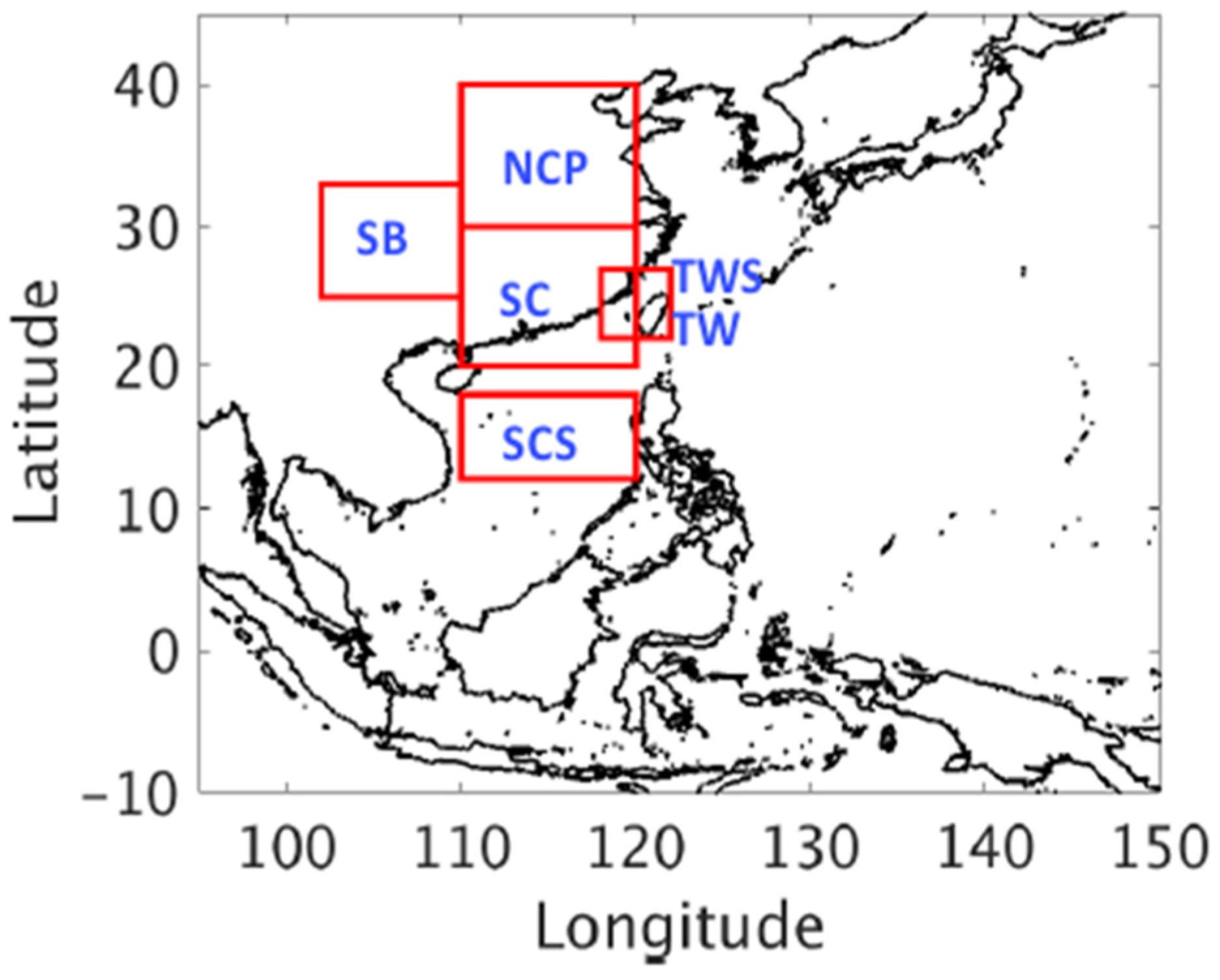
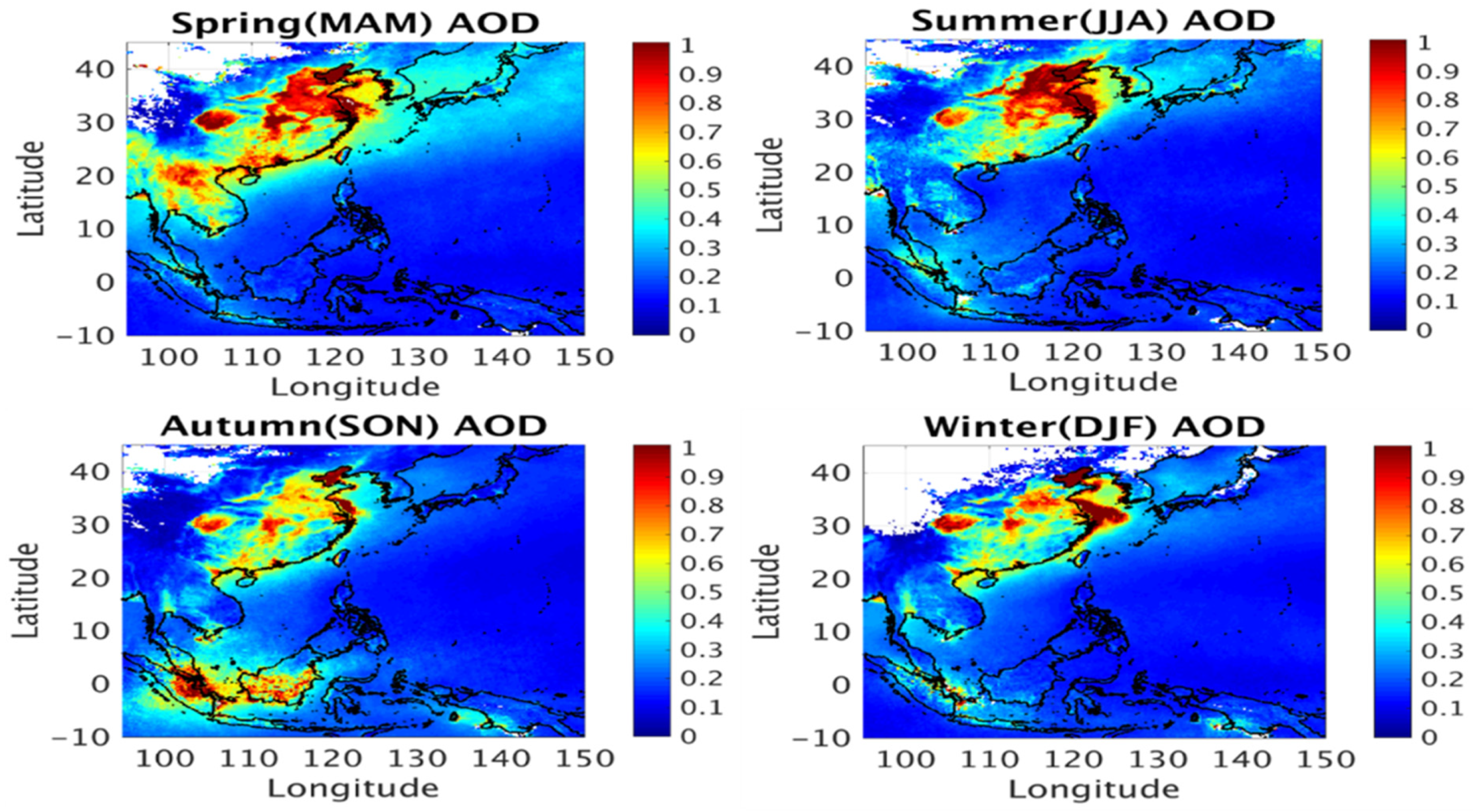
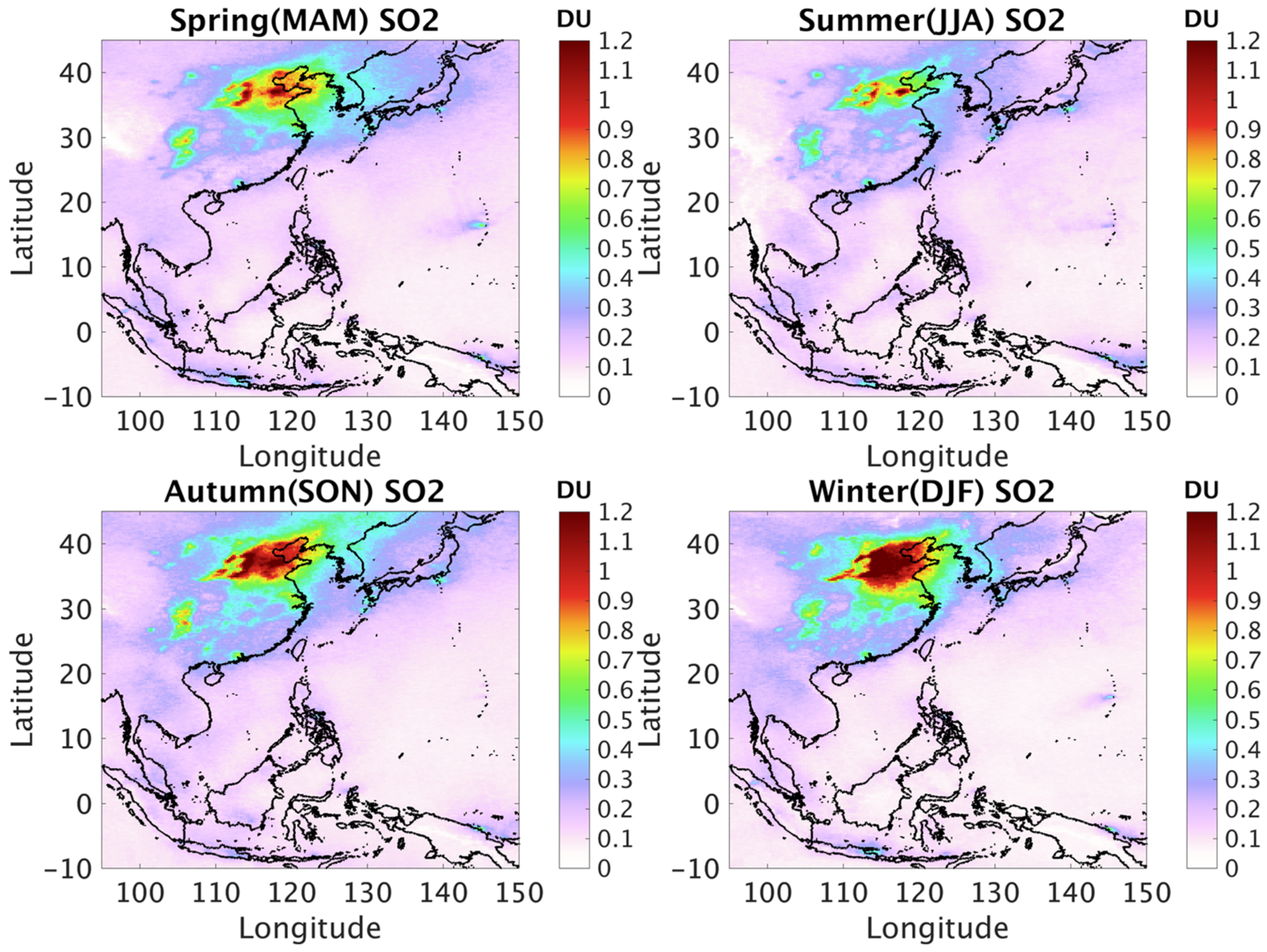
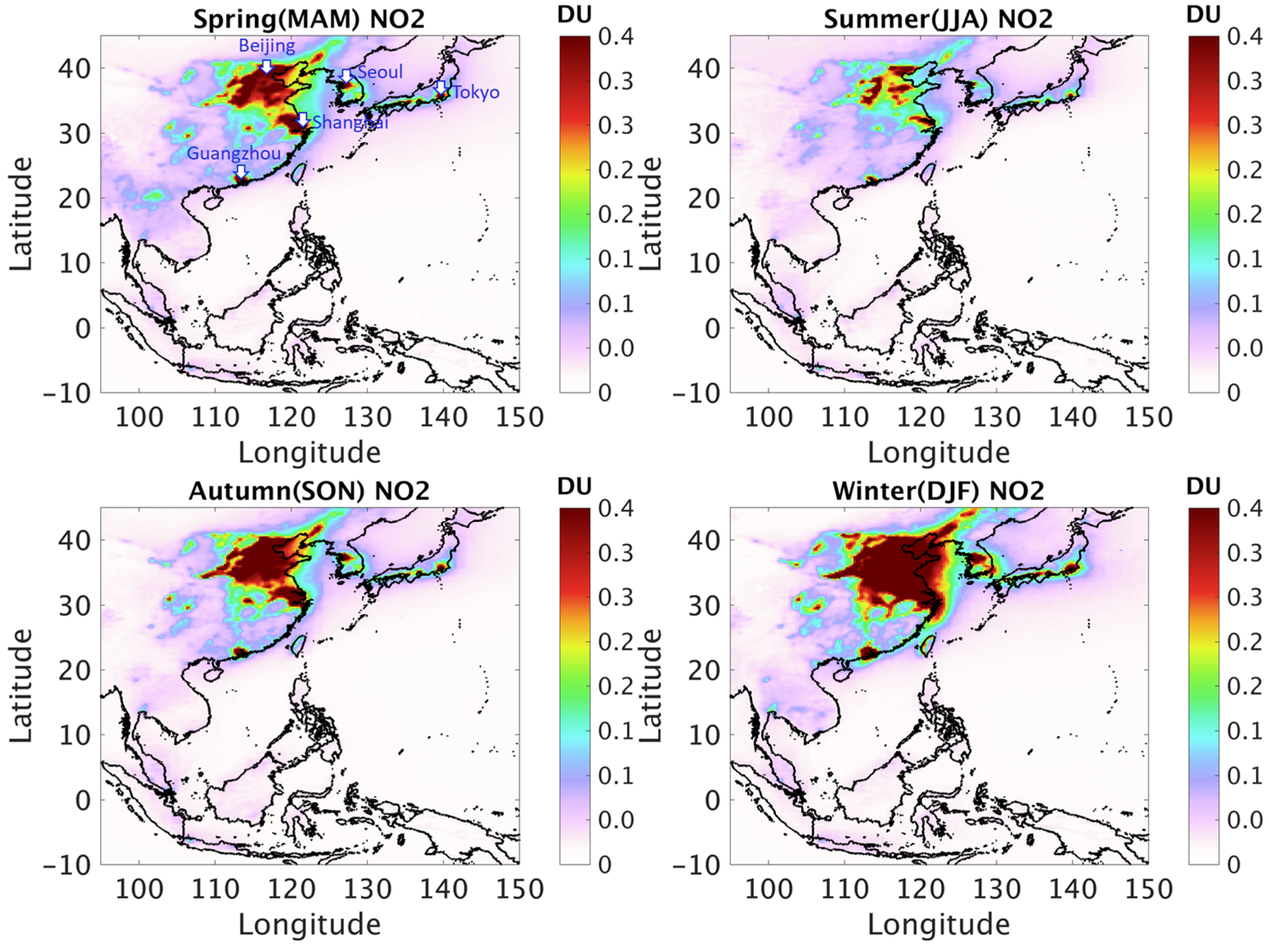
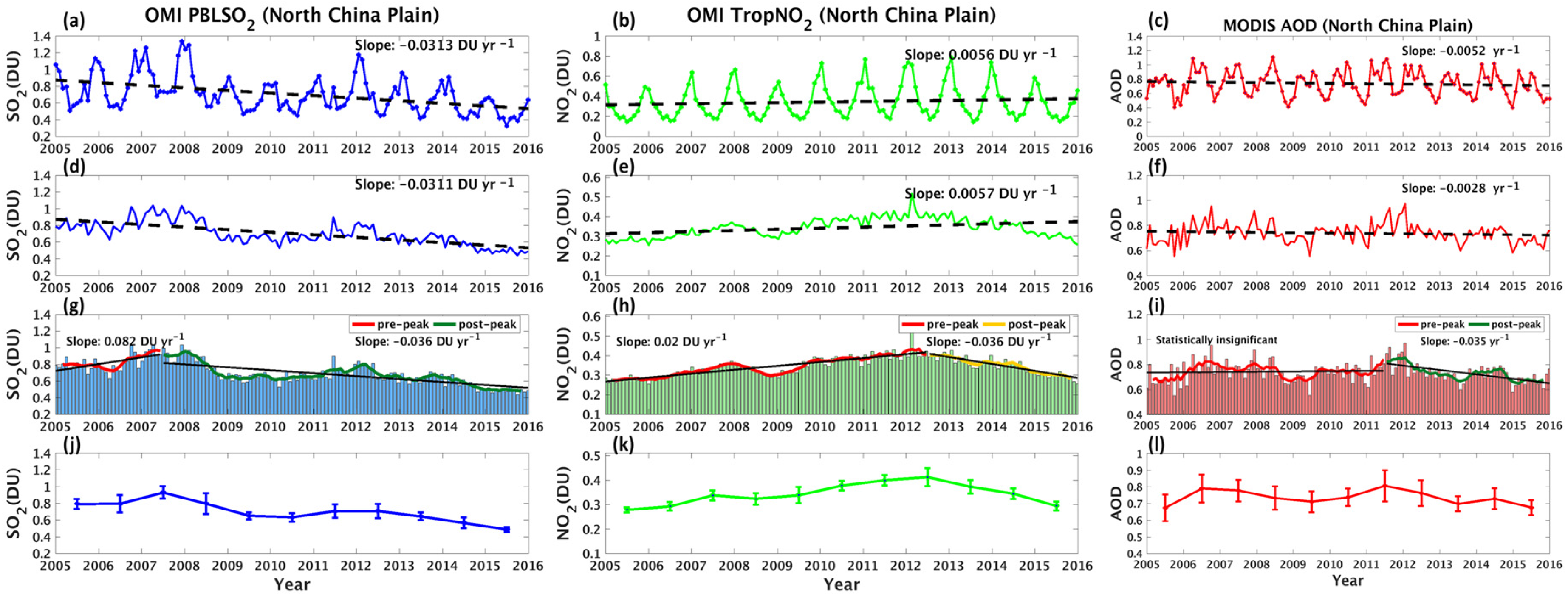

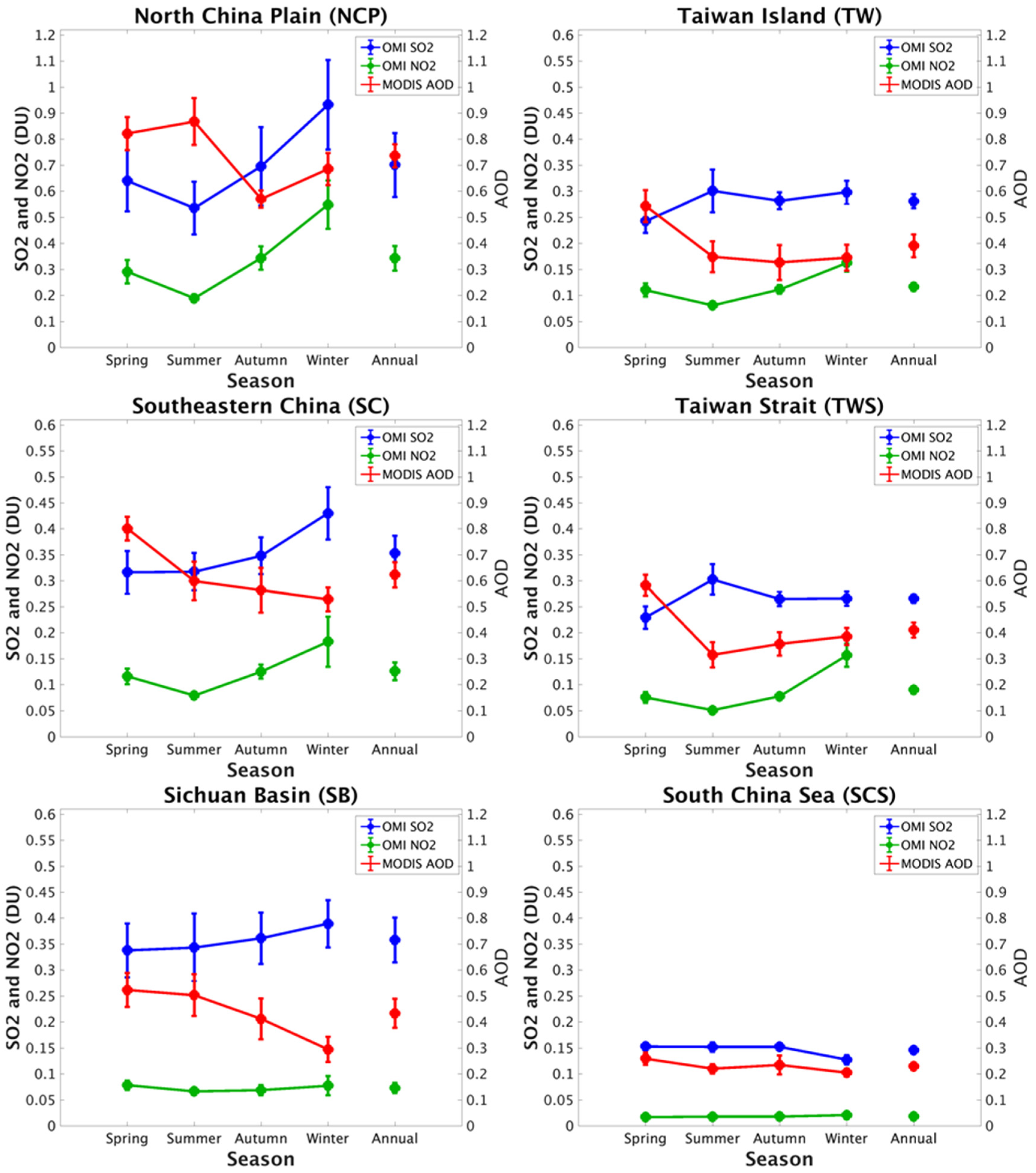
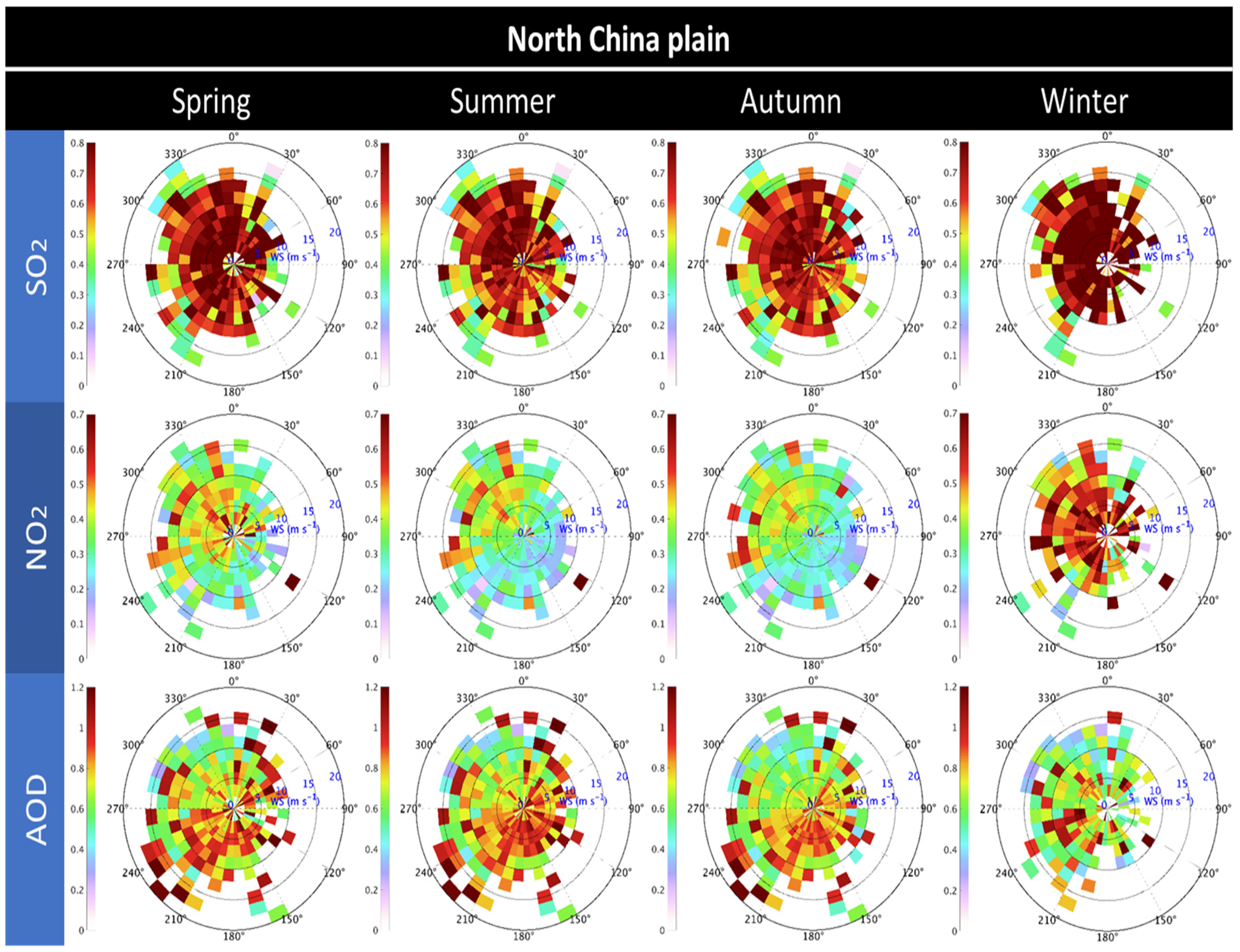
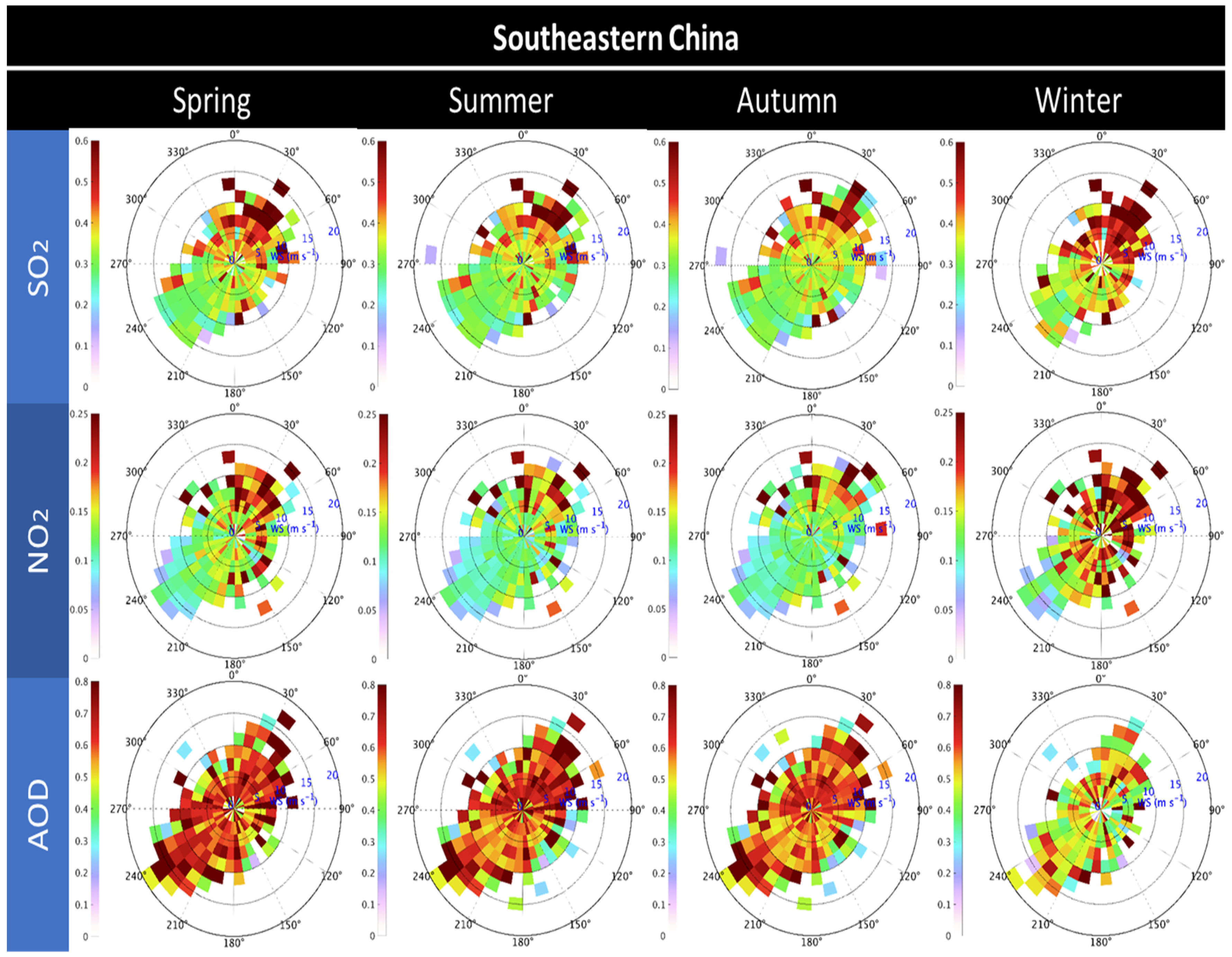

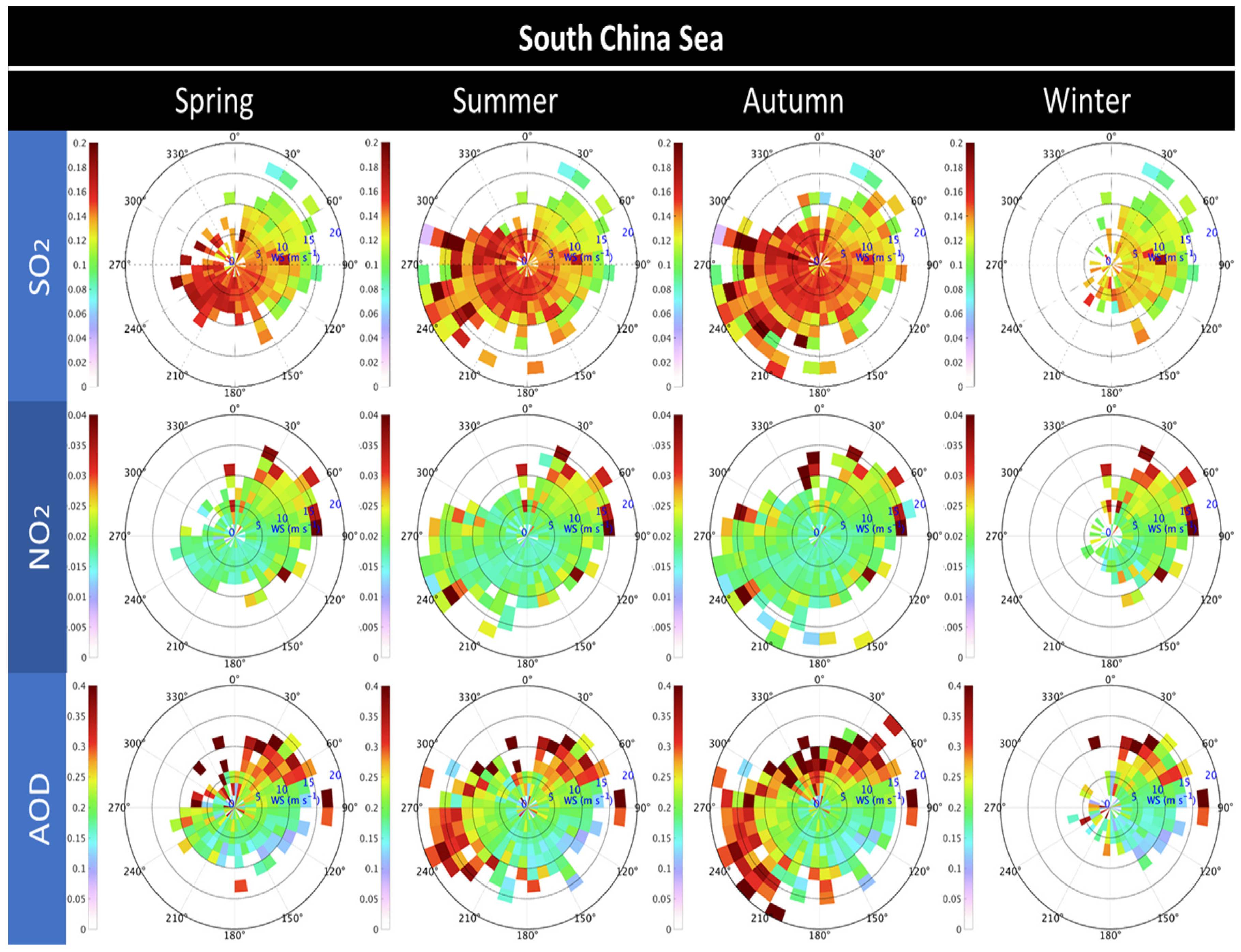

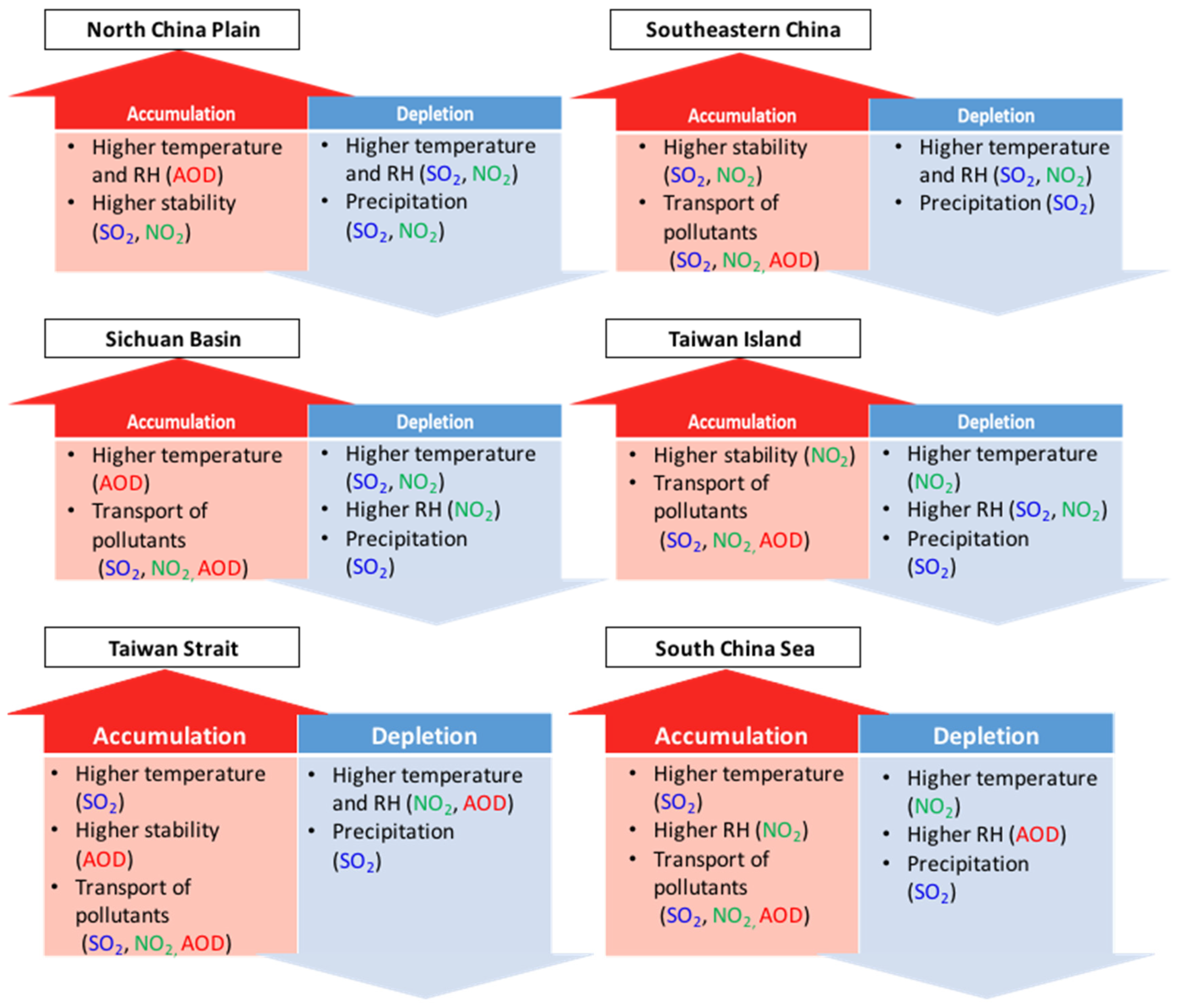
| North China Plain (NCP) | Taiwan Island (TW) | ||||||
| 850 hPa Temp | 850 hPa RH | LTS | 850 hPa Temp | 850 hPa RH | LTS | ||
| SO2 | −0.696 | −0.457 | 0.527 | SO2 | 0.007 | −0.175 | 0.086 |
| NO2 | −0.885 | −0.618 | 0.685 | NO2 | −0.871 | −0.391 | 0.632 |
| AOD | 0.351 | 0.356 | −0.435 | AOD | −0.082 | −0.086 | −0.358 |
| Southeastern China (SC) | Taiwan Strait (TWS) | ||||||
| 850 hPa Temp | 850 hPa RH | LTS | 850 hPa Temp | 850 hPa RH | LTS | ||
| SO2 | −0.542 | −0.574 | 0.408 | SO2 | 0.284 | 0.021 | −0.194 |
| NO2 | −0.811 | −0.656 | 0.743 | NO2 | −0.862 | −0.324 | −0.271 |
| AOD | 0.05 | 0.153 | −0.442 | AOD | −0.274 | −0.267 | 0.244 |
| Sichuan Basin (SB) | South China Sea (SCS) | ||||||
| 850 hPa Temp | 850 hPa RH | LTS | 850 hPa Temp | 850 hPa RH | LTS | ||
| SO2 | −0.310 | −0.127 | 0.128 | SO2 | 0.544 | 0.117 | −0.473 |
| NO2 | −0.328 | −0.420 | −0.167 | NO2 | −0.489 | 0.346 | 0.145 |
| AOD | 0.505 | 0.109 | −0.108 | AOD | 0.048 | −0.192 | 0.083 |
© 2019 by the authors. Licensee MDPI, Basel, Switzerland. This article is an open access article distributed under the terms and conditions of the Creative Commons Attribution (CC BY) license (http://creativecommons.org/licenses/by/4.0/).
Share and Cite
Lin, C.-A.; Chen, Y.-C.; Liu, C.-Y.; Chen, W.-T.; Seinfeld, J.H.; Chou, C.C.-K. Satellite-Derived Correlation of SO2, NO2, and Aerosol Optical Depth with Meteorological Conditions over East Asia from 2005 to 2015. Remote Sens. 2019, 11, 1738. https://doi.org/10.3390/rs11151738
Lin C-A, Chen Y-C, Liu C-Y, Chen W-T, Seinfeld JH, Chou CC-K. Satellite-Derived Correlation of SO2, NO2, and Aerosol Optical Depth with Meteorological Conditions over East Asia from 2005 to 2015. Remote Sensing. 2019; 11(15):1738. https://doi.org/10.3390/rs11151738
Chicago/Turabian StyleLin, Chin-An, Yi-Chun Chen, Chian-Yi Liu, Wei-Ting Chen, John H. Seinfeld, and Charles C.-K. Chou. 2019. "Satellite-Derived Correlation of SO2, NO2, and Aerosol Optical Depth with Meteorological Conditions over East Asia from 2005 to 2015" Remote Sensing 11, no. 15: 1738. https://doi.org/10.3390/rs11151738
APA StyleLin, C.-A., Chen, Y.-C., Liu, C.-Y., Chen, W.-T., Seinfeld, J. H., & Chou, C. C.-K. (2019). Satellite-Derived Correlation of SO2, NO2, and Aerosol Optical Depth with Meteorological Conditions over East Asia from 2005 to 2015. Remote Sensing, 11(15), 1738. https://doi.org/10.3390/rs11151738






